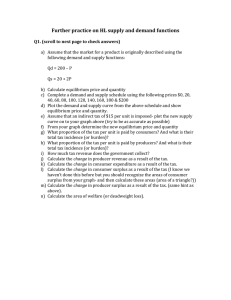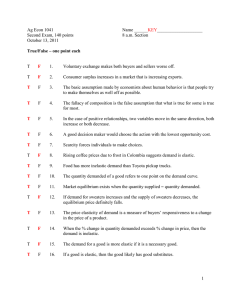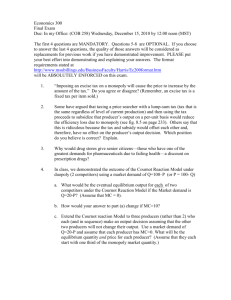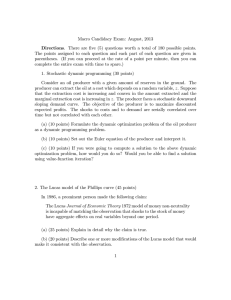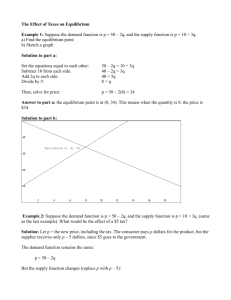Zenginobuz/EC 351
advertisement
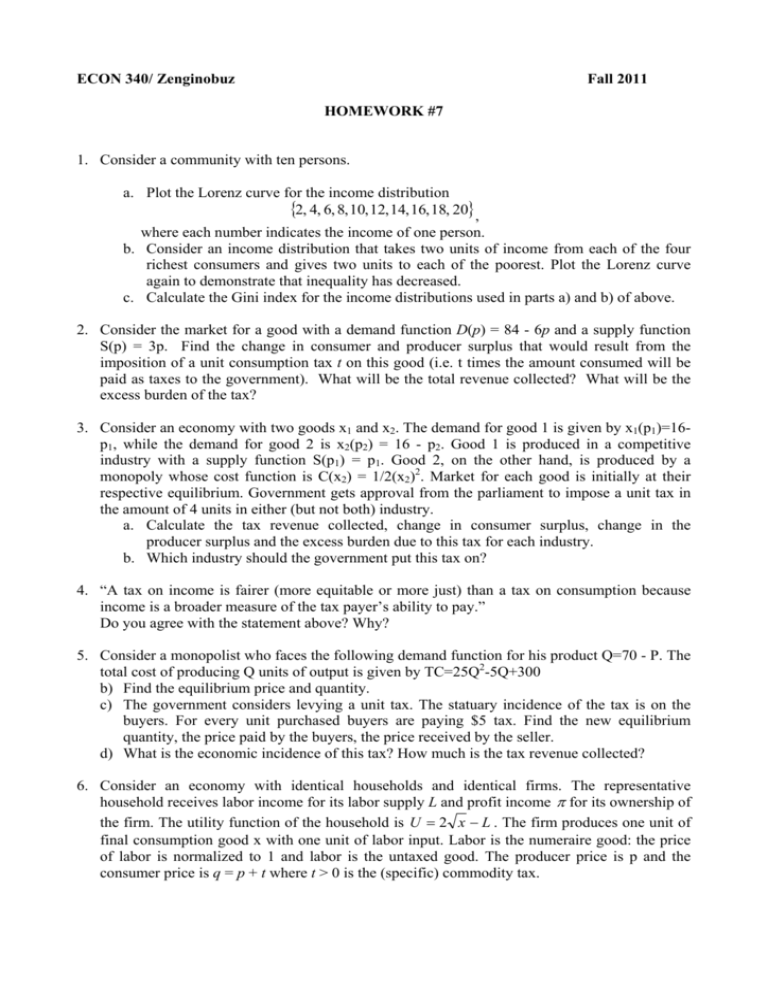
ECON 340/ Zenginobuz
Fall 2011
HOMEWORK #7
1. Consider a community with ten persons.
a. Plot the Lorenz curve for the income distribution
{2, 4, 6, 8, 10, 12, 14, 16, 18, 20},
where each number indicates the income of one person.
b. Consider an income distribution that takes two units of income from each of the four
richest consumers and gives two units to each of the poorest. Plot the Lorenz curve
again to demonstrate that inequality has decreased.
c. Calculate the Gini index for the income distributions used in parts a) and b) of above.
2. Consider the market for a good with a demand function D(p) = 84 - 6p and a supply function
S(p) = 3p. Find the change in consumer and producer surplus that would result from the
imposition of a unit consumption tax t on this good (i.e. t times the amount consumed will be
paid as taxes to the government). What will be the total revenue collected? What will be the
excess burden of the tax?
3. Consider an economy with two goods x1 and x2. The demand for good 1 is given by x1(p1)=16p1, while the demand for good 2 is x2(p2) = 16 - p2. Good 1 is produced in a competitive
industry with a supply function S(p1) = p1. Good 2, on the other hand, is produced by a
monopoly whose cost function is C(x2) = 1/2(x2)2. Market for each good is initially at their
respective equilibrium. Government gets approval from the parliament to impose a unit tax in
the amount of 4 units in either (but not both) industry.
a. Calculate the tax revenue collected, change in consumer surplus, change in the
producer surplus and the excess burden due to this tax for each industry.
b. Which industry should the government put this tax on?
4. “A tax on income is fairer (more equitable or more just) than a tax on consumption because
income is a broader measure of the tax payer’s ability to pay.”
Do you agree with the statement above? Why?
5. Consider a monopolist who faces the following demand function for his product Q=70 - P. The
total cost of producing Q units of output is given by TC=25Q2-5Q+300
b) Find the equilibrium price and quantity.
c) The government considers levying a unit tax. The statuary incidence of the tax is on the
buyers. For every unit purchased buyers are paying $5 tax. Find the new equilibrium
quantity, the price paid by the buyers, the price received by the seller.
d) What is the economic incidence of this tax? How much is the tax revenue collected?
6. Consider an economy with identical households and identical firms. The representative
household receives labor income for its labor supply L and profit income π for its ownership of
the firm. The utility function of the household is U = 2 x − L . The firm produces one unit of
final consumption good x with one unit of labor input. Labor is the numeraire good: the price
of labor is normalized to 1 and labor is the untaxed good. The producer price is p and the
consumer price is q = p + t where t > 0 is the (specific) commodity tax.
a. Describe the household’s optimization problem treating profit income and the
consumer prices in the budget constraint as fixed. Find the demand for good x as a
function of consumer price q.
b. Calculate the elasticity of the slope of the inverse demand function.
c. Suppose the firm acts like a monopolist. Find the supply of the monopoly as a function
of t.
d. What is the equilibrium price charged by the monopolist? What is the producer price?
What is the division of the tax burden between the producer and the consumer?
e. Suppose that the firm acts like competitive firm, maximizing its profit taking the
market price as given. What is the equilibrium producer price? What is the division of
the tax burden between producer and consumer? Compare with the result in d.
7. Consider an economy whose representative individual has the utility function
U (x1 , x 2 , x3 ) = α 1 ln x1 + α 2 ln x 2 + (1 − α 1 − α 2 ) ln l ,
where x1 and x2 are the consumption levels of good 1 and good 2, and l is leisure.(assume that
α1 ε [0,1] and α2 ε [0,1]). Let pi be the price of good i, i = 1,2, and w be the wage rate . Let
L0 be the total time (leisure) endowment the individuals have.
a. First consider the case where the individual earns a fixed income of I but where w = 0.
Calculate his consumption bundle (values of x1, x2 and l) in the absence of any taxes.
b. Government needs to raise Ro amount of tax revenue (to use for some purpose which
does not directly affect individuals’ utility). With income as given in (a), should it raise
it through a (optimal) consumption tax or a (optimal) proportional income tax? Why?
Calculate the tax rate(s) for the type of tax you would argue that government should
choose. (Note that the government can choose either the consumption tax or the income
tax, but not both at the same time).
c. Now let w > 0, i.e. individuals can earn wage income in addition their fixed income I.
Answer all of the questions in part (b) for this case.
8. Consider the Cobb-Douglas utility function
, with
, where is
the before-tax income and is the tax paid by person i and G is the consumption level of a
, where N is the
public good. Tax revenues are used to finance the public good:
number of persons in this society.
a. Suppose that a poll tax
for all i is levied on each of N members of society. Find
the majority voting outcome level for the public good. (Note: Denote the before-tax
income of the median voter by )
b. Now suppose that a proportional income tax
is levied. Find the majority voting
outcome in this case. (Note: Denote the mean income level )
c. When income is uniformly distributed, which outcome is closest to the efficient
outcome.
9. Consider the utility function
and the budget constraint
, where
and
are after-tax prices of goods X and Y, and x and y are the respective consumption
levels of these goods.
a. Find the price elasticity of demand for both commodities.
b. Suppose the producer prices are set at
. Apply the inverse elasticity rule to
find how the (specific) tax rates and should be set for an optimal consumption tax
design.
c. Let
and
. Calculate the tax rates required to achieve revenue of
.
